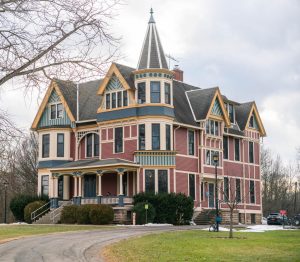Stull Recital Hall Boasts Aesthetics, Not Acoustics
December 6, 2013
The David H. Stull Recital Hall in the Conservatory was recently granted the Honor Award, the highest accolade of Cleveland-area chapters of the American Institute of Architects and the American Society of Interior Designers. But its distinguished prize aside, the new space has experienced its share of criticism. Many Conservatory students have complained about the acoustics, which have proved an inconvenience for both the students rehearsing and performing in the space, and those below, on the second floor of Bibbins Hall.
“The things I’ve heard are [that the sound] bleeds into the second floor; you can hear it depending on what instrument is playing [and] it bleeds into the rooms right next to it,” said Conservatory senior Ethan Updike.
Officially completed on Oct.1, the hall was named in honor of former Oberlin Conservatory Dean David H. Stull OC ’89, who served as dean for nine years.
Like most buildings in the Conservatory, the acoustics in Stull Hall are presumed to be exceptional. But in this case, the hall appears to have architectural problems relating to its acoustics –– surprising for a building that was awarded the highest honor by the American Society of Architects.
Stull Recital Hall is located atop Bibbins as part of the hall’s ongoing renovation, which is a part of a larger campus plan to deal with the maintenance of its aging facilities. The Conservatory’s main buildings are almost 50 years old and have some deferred maintenance issues as a result. In response, the administration began a multi-year process to address these problems and update the main teaching facilities. The administration was able to combine two classrooms on the third floor to create the new performance space, which is utilized for studio classes, recitals, chamber music coachings and performances, master classes and guest lectures.
Before Stull Hall was erected, the primary rehearsal and recital spaces for students were Kulas Recital Hall and Warner Concert Hall. With only two rehearsal and recital spaces, Conservatory students often found it difficult to secure enough time in each desired space.
The new Stull Recital Hall has mitigated this problem somewhat and serves as a venue space for visiting artists. “A lot of people have been having rehearsals up there, a lot of people have been having recitals there, and the Punch Brothers were up there performing this Monday,” Updike noted.
Certain students have wondered if the new recital hall would have been better placed elsewhere, but others saw the top of Bibbins as the best option. Double Degree Senior Daniel Pappalardo, a bass player in the spoke to its advantages, remarking, “It’s useful to have it in the same space as the rest of the Conservatory. I would say if they were going to build a recital hall, this was the one to build.”
Pappalardo also considered the space beneficial for the conservatory at large. “Just a few weeks ago, there was a big jam in all of the halls as you saw people trying to get their stuff together for their recitals. I can’t imagine how bad it would’ve been if they didn’t have [this new space.] The conservatory is growing, they need more performance spaces.”
Pappalardo also praised the hall for its architecture, remarking, “I’ve taken advantage of it pretty directly, what I use it for is just writing some music. Most halls or recording studios you’d ever be in have this element of being closed off from the outside world, but the recital hall is really gorgeous –– it’s all windows, it looks over Tappan.”
While certain Conservatory students have taken advantage of the space, students in both the College and Conservatory have questioned the resources involved, and whether this should have been a priority, or if the Conservatory should have used these finances elsewhere to create more safe spaces.
Despite the criticism, Interim Dean of the Conservatory Andrea Kalyn insisted that the Hall does more good than harm. “Maintaining our teaching facilities is critical to providing a great education for our students, and so is a vital capital priority. Some of the construction decisions that made sense in the ’60s when Bibbins was built are not standing the test of time, and we will have serious structural issues if we don’t deal with those in a timely manner. As we do that, it is our responsibility to think creatively and intelligently to ensure that we are investing our capital resources in ways that strengthen the core work of the institution and ensure superlative educational experiences for our students.”
Kalyn added that “Stull Hall certainly will emerge as an important space as we enter student recital season, not just in its specific use, but also in relieving some of the pressure on the other halls.”
























